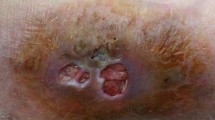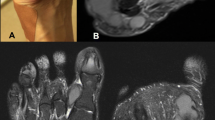Abstract
Bone marrow transplant recipients are highly susceptible to opportunistic fungal infections. This is the report, of the first case of a Chaetomium systemic infection described in Brazil. A 34 year-old patient with chronic myeloid leukemia underwent an allogeneic sibling matched bone marrow transplant. Seven months later, he developed systemic infection with enlargement of the axillary and cervical lymph nodes. Culture of the aspirates from both lymph nodes yielded Chaetomium globosum. The infection was successfully treated with amphotericin B. The increasing population of immunosupressed patients requires a careful microbiologic investigation for uncommon fungal infections.
Similar content being viewed by others
References
Woods GL, Davis JC, Vaughan WP. Failure of the sterile airflow component of a protected environment detected by demonstration of Chaetomium species colonization of four consecutive immunosupressed occupants. Infect Control Hops Epidemiol 1988; 9(10): 451–456.
Lesire V, Hazouard E, Dequim PF, et al. A. Possible role of Chaetomium globosum in infection after autologous bone marrow transplantation. Intensive Care Med 1999; 25(1): 124–125.
Oliveira Lima A, Seabra O, França AT, et al. Incidência de fungos da atmosfera de algumas cidades brasileiras. Hospital. 1963; 53: 1045–1054.
Passarelli N, Miranda MP, Castro C. A study of the incidence of air-borne fungi in the city of Rio de Janeiro. Ann Allergy 1949; 7: 334–338.
Lacaz Cs, Porto E, Martins JEC. Fungos e alergia. Fungos contaminantes. In: Lacaz Cs, Porto E, Martins JEC, eds. Micologia Médica. Fungos, Actinomicetos e Algas de interesse médico. São Paulo: Sarvier; 1984: 337–349.
Costa AR, Porto E, Lacaz, CS, et al. Cutaneous and ungueal phaeohyphomycosis caused by species of Chaetomium Kunze (1817) ex Fresenius, 1829. J Med Vet Mycol 1988; 26: 261–268.
Koch FA, Haneke H. Chaetomium funicolum Cooke als moglicher erreger eme tiefen mykose. Mykosen 1965; 9: 23–28.
Hoppin EC, McCoy EL, Rinaldi MG. Opportunistic mycotic infection Caused by Chaetomium in a patient with acute leukemia. Cancer 1983; 1(52)(S3): 555–556.
Anandi V, John, TJ, Walter A, et al. Cerebral phaeohyphomycosis caused by Chaetomium globosum in a renal transplant recipient. J Clin Microbiol 1989; 27(10): 2226–2229.
Yeghen T, Fenelon L, Campbell Ck, et al. Chaetomium pneumonia in patient with acute myeloid leukemia. J Clin Pathol 1996; 49: 184–186.
Hattori N, Adachi M, Kaneko, T, et al. Case report. Onychomycosis dur to Chaetomium globosum successfully treated with itraconazole. Mycoses 2000; 43: 89–92.
Stiller MJ, Rosenthal S, Summerbell RC. Onychomycosis of the toenails caused by Chaetomium globosum. J Am Acad Dermatol 1992; 26(5)(S1): 775–776.
Naidu J, Pouranik M. Onychomycosis caused by Chaetomium globosum Kunze. Mycopathologia 1991; 113: 31–34.
Kwon-Chung KJ, Bennett JE. Phaeohyphomycosis. In: Kwon-Chung KJ, Bennett JE, eds. Medical Mycology. Philadelphia: Lea & Febiger, 1992; 620–677.
Thomas C, Mileusnic D, Carey RB, et al. Fatal Chaetomium cerebritis in a bone marrow transplant patient. Hum Pathol 1999; 30: 874–879.
Guppy KH, Thomas C, Thomas K, et al. Cerebral fungal infections in the immunocompromissed host: A literature review and a new pathogen –Chaetomium atrobrunneum: Case report. Neurosurgery 1998; 43(6): 1463–1469.
Segal R, Kusne S. Cerebral fungal infections in the immunocompromissed host: A literature review and a new pathogen –Chaetomium atrobrunneum: Case report. Neurosurgery 1999; 45(1): 200.
Abbot SP, Sigler L, McAlfer R, et al. Fatal cerebral mycoses caused by ascomycete Chaetomium strumarium. J Clin Microbiol 1995; 33(10); 2692–2698.
National Committee for clinical Laboratory Standards (NCCLS). Reference method for broth dilution and antifungal susceptibility testing of filamentous fungi; proposed standard. Villanova, NCCLS, 1998, M-38P.
Vartivarian SE, Anaissie FJ, Bodey GP. Emerging fungal pathogens in immunocomprom issed patients: Classification, diagnosis, and management. Clin Infect Dis 1993; 17(S2): 487–491.
Almeida F de, Gomes, JM, Salles C. Considerações sobre uma amostra de “Chaetomium” isolada de uma lesão epidèrmica. An Fac Med Univer São Paulo; 1944; 20: 145–154.
Guarro J, Soler L, Rinaldi MG. Pathogenicity and antifungal susceptibility of Chaetomium species. Eur J Clin Microbiol Infect Dis 1995; 14: 613–618.
Iwen PC, Davis, JC, Reed EC, et al. Airborne fungal spore monitoring in a protective environment during hospital construction, and correlation with an outbreak of invasive Aspergillosis. Infect Control Hosp Epidemiol 1994; 15(5): 303–306.
Author information
Authors and Affiliations
Rights and permissions
About this article
Cite this article
Teixeira, A., Trabasso, P., Moretti-Branchini, M. et al. Phaeohyphomycosis Caused by Chaetomium Globosum in an Allogeneic Bone Marrow Transplant Recipient. Mycopathologia 156, 309–312 (2003). https://doi.org/10.1023/B:MYCO.0000003563.29320.95
Issue Date:
DOI: https://doi.org/10.1023/B:MYCO.0000003563.29320.95




